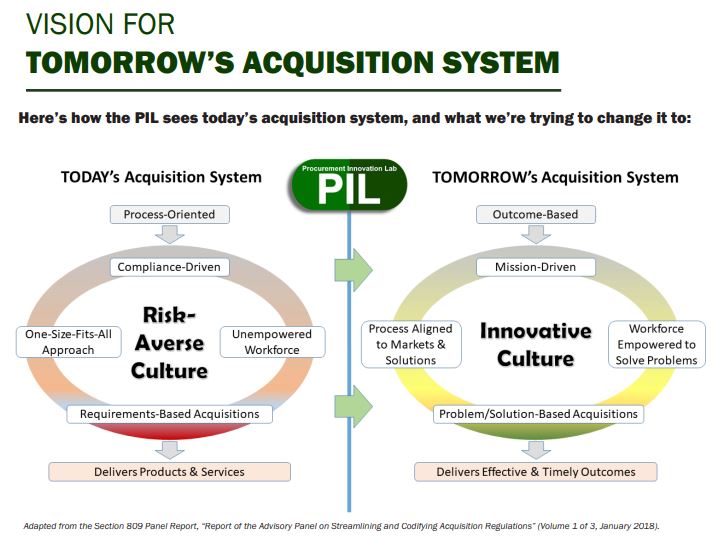
Exclusive
How DHS’ innovation lab is helping other acquisition offices get into shape
Soraya Correa, the DHS chief procurement officer, said the Procurement Innovation Lab is taking what’s already in the Federal Acquisition Regulations and thinking...
Best listening experience is on Chrome, Firefox or Safari. Subscribe to Federal Drive’s daily audio interviews on Apple Podcasts or PodcastOne.
If a recent survey of federal acquisition workers is right, there is a growing desire for innovation in procurement. The questions one would have to ask are which agencies are being innovative, does innovation even exist and is the risk worth it?
Soraya Correa, the Homeland Security Department chief procurement officer, said she can answer all of those questions. Correa said DHS’ Procurement Innovation Lab (PIL) continues to pave the path to take smart, innovative acquisition risks.

“One of the features we’ve added to the PIL [is] called the PIL boot camp. The PIL boot camp is basically an immersed, course-less study on how to conduct a procurement innovation lab project,” said Correa in an exclusive interview with Federal News Radio. “We have the opportunity to bring in students, in this case when we did DHS only, we brought in folks from across the department to learn more about how to participate in a project and learn some of the innovative techniques that we have. People walk out of the course not only understanding what our innovative techniques are, but encouraged and motivated to go out and innovative and be innovative in the constructs of the Federal Acquisition Regulations (FAR).”
The boot camp has been so successful that DHS recently conducted two more on behalf of the Office of Federal Procurement Policy, and received invitations from several agencies to conduct individual boot camps.
“What we really teach folks is to take many of the principles that are in the FAR and think a little bit outside the box,” Correa said. “One example is oral presentations. Oral presentations have been around forever, but it’s how you do the oral presentations. It’s making sure that you create an opportunity to get really good interactive dialogue going between government and industry, working to get better information.”
She said another example is product or technical demonstration where the agency uses the “show me, don’t tell me” approach to evaluations, “rather than me reading a couple of hundred pages that may discuss how the product could work, but may not necessarily show me the features of the product.”
A third example is using the downselect process where, through different phases of the procurement, the agency reduces the number of competitors based on evaluation factors.
“You can do a voluntary downselect, a mandatory downselect, there’s whole bunch of ways you can do that. It’s all up to how clever you want to be, how smart you want to be and talking to industry about what they think will work,” she said. “That is one of the things the PIL has been doing. We consistently communicate with industry and try to learn from them and try to share our ideas with them so they understand what we are trying to do. I believe innovation exists. Innovation is only limited by the fear that we introduce into our organizations, the fear of protests, the fear of lacking leadership support. Those are the things that limit innovation.”
The reason DHS launched the PIL in 2015 is to create a safe place to overcome those fears. The boot camp grew from several successes and failures the PIL has experienced.
Correa released the PIL’s first annual report earlier this summer highlighting the organization’s accomplishments in fiscal 2017. The PIL has completed 26 procurement projects using innovative techniques to accomplish one or more goals:
- Improving or encouraging better competition
- Reducing time to award
- Cost savings
- Better mission outcomes
“We are about testing, experimenting and sharing. We talk about this continuous cycle of testing, getting feedback, sharing that information and then even retesting,” Correa said. “The first thing we talk about is you can’t be afraid of making mistakes and failing. That is part of the learning process. We learn as much from our mistakes as we do from our successes.”

One way the PIL ensures that learning is by bringing in the people who run the projects to discuss the innovations and the mistakes they made in webinars for all DHS to see.
The PIL currently has 19 active projects, and 12 that have or currently are focused on streamlining the business processes program managers have to follow.
“In the business process area, we looked at how we conduct document reviews and eliminated one of those business processes by getting rid of individual evaluations and moved right to consensus evaluations,” Correa said. “We also streamlined how we conduct evaluations. We are not relying solely on adjectival ratings, but we look at the confidence rating of the solution. We also talk a lot about following the process you said you’d follow. Too often we mix processes together, which can create confusion for industry and lead to protests.”
Correa said heading into 2019 and beyond the PIL will continue to push for more innovation with more and more DHS components.
“Our big goal is sharing best practices internally and with other federal agencies to improve the acquisition process and the people who do acquisitions themselves,” she said.
Copyright © 2025 Federal News Network. All rights reserved. This website is not intended for users located within the European Economic Area.
Jason Miller is executive editor of Federal News Network and directs news coverage on the people, policy and programs of the federal government.
Follow @jmillerWFED
Related Stories





